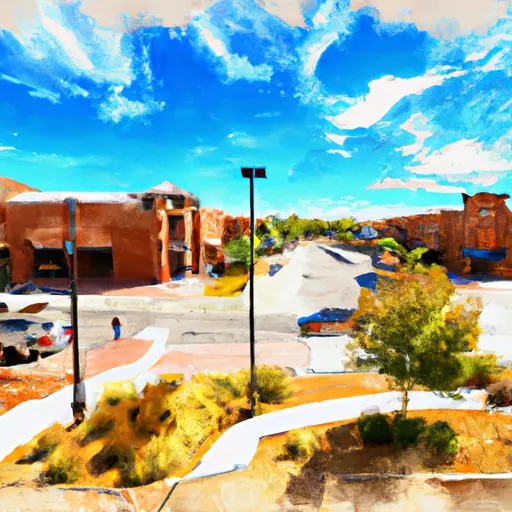-
 Snoflo Premium
Snoflo Premium
Get unlimited access to all our content
With no Ad interruptions! - Start Your Free Trial Login with existing account
Mesa
Eden Index
Climate
8.6
•
Recreation
7.0
•
Community
•
Safeguard
5.9/10

Mesa, Colorado, located in Mesa County, is a small town nestled in the high desert of western Colorado. The region experiences a semi-arid climate, characterized by hot summers and cold winters. Summers are typically dry with temperatures averaging in the high 80s°F, while winters are cold and snowy, with temperatures often dropping below freezing. The area's hydrology constituents consist of various rivers and streams, including the Colorado River, which flows through the region and provides a source of water for agricultural and recreational activities.
Mesa offers a range of outdoor recreation opportunities for nature enthusiasts. The nearby Grand Mesa National Forest is a popular destination for hiking, camping, fishing, and wildlife watching. With over 300 lakes and reservoirs, the area provides ample opportunities for boating and fishing. In winter, visitors can enjoy activities such as skiing, snowboarding, and snowshoeing in the nearby Powderhorn Mountain Resort. The beautiful landscapes and picturesque views of the Colorado National Monument, a short drive from Mesa, also attract visitors for rock climbing, hiking, and cycling.
Overall, Mesa, Colorado offers a diverse climate, abundant hydrology constituents, and numerous outdoor recreational opportunities, making it an appealing destination for nature lovers and outdoor enthusiasts.
What is the Eden Index?
The Snoflo Eden Index serves as a comprehensive rating system for regions, evaluating their desirability through a holistic assessment of climate health, outdoor recreation opportunities, and natural disaster risk, acknowledging the profound impact of these factors on livability and well-being.
Climate Health Indicator (CHI): 8.6
Mesa receives approximately
513mm of rain per year,
with humidity levels near 56%
and air temperatures averaging around
9°C.
Mesa has a plant hardyness factor of
6, meaning
plants and agriculture in this region thrive during a short period during spring and early summer. Most
plants will die off during the colder winter months.
By considering the ideal temperature range, reliable water supplies, clean air, and stable seasonal rain or snowpacks, the Climate Health Indicator (CHI) underscores the significance of a healthy climate as the foundation for quality living.
A healthy climate is paramount for ensuring a high quality of life and livability in a region, fostering both physical well-being and environmental harmony. This can be characterized by ideal temperatures, reliable access to water supplies, clean air, and consistent seasonal rain or snowpacks.
Weather Forecast
Streamflow Conditions
Colorado Headwaters
Area Rivers
Colorado Headwaters
Snowpack Depths
Colorado Headwaters
Reservoir Storage Capacity
Colorado Headwaters
Groundwater Levels
Recreational Opportunity Index (ROI): 7.0
The Recreational Opportunity Index (ROI) recognizes the value of outdoor recreational options, such as parks, hiking trails, camping sites, and fishing spots, while acknowledging that climate plays a pivotal role in ensuring the comfort and consistency of these experiences.
Access to outdoor recreational opportunities, encompassing activities such as parks, hiking, camping, and fishing, is crucial for overall well-being, and the climate plays a pivotal role in enabling and enhancing these experiences, ensuring that individuals can engage in nature-based activities comfortably and consistently.
Camping Areas
| Campground | Campsites | Reservations | Toilets | Showers | Elevation |
|---|---|---|---|---|---|
| Spruce Grove - Mesa | 16 | 9,961 ft | |||
| Island Acres - James M. Robb - Colorado River State Park | 60 | 4,764 ft | |||
| Kiser Creek | 12 | 10,112 ft | |||
| Jumbo | 26 | 9,791 ft | |||
| Ward Lake | 27 | 10,222 ft | |||
| Island Lake | 41 | 10,432 ft | |||
| Carp Lake | 20 | 10,267 ft | |||
| Collbran - Cottonwood Lake | 56 | 9,946 ft |
Nearby Ski Areas
Catastrophe Safeguard Index (CSI):
The Catastrophe Safeguard Index (CSI) recognizes that natural disaster risk, encompassing floods, fires, hurricanes, and tornadoes, can drastically affect safety and the overall appeal of an area.
The level of natural disaster risk in a region significantly affects safety and the overall livability, with climate change amplifying these risks by potentially increasing the frequency and intensity of events like floods, fires, hurricanes, and tornadoes, thereby posing substantial challenges to community resilience and well-being.
Community Resilience Indicator (CRI):
The Community Resilience Indicator (CRI) recognizes that education, healthcare, and socioeconomics are crucial to the well-being of a region. The CRI acknowledges the profound impact of these elements on residents' overall quality of life. By evaluating educational resources, healthcare accessibility, and economic inclusivity, the index captures the essential aspects that contribute to a thriving community, fostering resident satisfaction, equity, and social cohesion.

